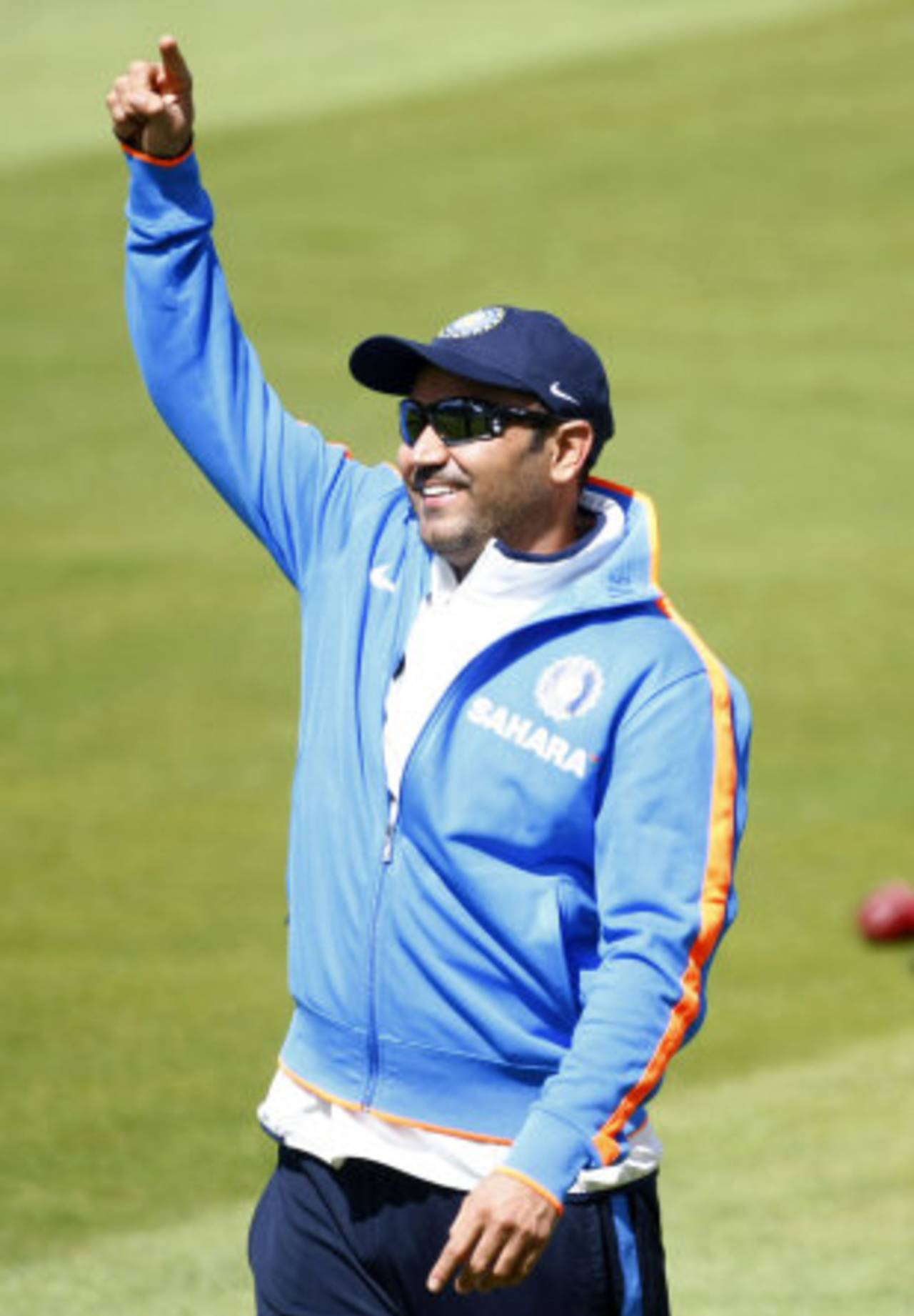Wanted, the Sehwag of old
For India to have a chance of leaving England with a Test victory, they need Virender Sehwag to attack, but only after settling in
Sharda Ugra at The Oval
17-Aug-2011

Virender Sehwag's king pair contributed heavily to India's crushing defeat at Edgbaston • Associated Press
Virender Sehwag remembers 2007, when India were touring England, taking on jellybeans and giving swing-bowling lessons. Sehwag was at home in Delhi, watching the series on television and experiencing, for the first time in his Test career, what being dropped felt like.
Of all the Indian 'galacticos' on this tour, only Sehwag may still be around when India return to England but that too would be touch and go. It would be a pity were Sehwag to leave The Oval without a trademark fireworks display because he has a unique place not just in this team but in Test history as well.
England is where Sehwag was launched as a Test opener who rewrote not just rules but entire rulebooks about the technique needed to succeed in England, the mandatory temperament required for an opener and the divine power of footwork. Sehwag brought a completely different dimension to the opener's role in Test matches and, with it, has become the most attacking Test opener in the game's history, even with the generous cut-off of at least 1000 Test runs.
Yet, on the eve of the final Test of India's anti-climactic tour of England, Sehwag is just another struggling Indian opener with a king pair to his name. Just that thought should make him slash at the first ball he faces over slips for six, except that he is a man rarely given to rage - other than in the ferocity of stroke play.
The Sehwag India need, to steady its wobbling axis, is not merely the 45-minute whirwind but the assured batsman who took away India's trepidation around opening stands, opened up matches in sessions and allowed others to play their own game. That man, however, has been missing on India's previous two tours outside the subcontinent. In New Zealand and South Africa, series separated by 20 months, Sehwag scored one fifty in 11 innings - a top score of 63 - and averaged 25.81. That is as un-Sehwag-like a performanceas were his Edbaston ducks. Instead of working his way through a cricketing convalescence after shoulder surgery, Sehwag believed he could burst out the door.
His captain MS Dhoni, however, brushed off the two failures. "If you see Virender Sehwag, irrespective of where he is playing, what the conditions are, he plays his own game. He backs himself to play shots and at times he may get out. So you may say it was one of those games where he got out."
Sehwag may well be a batsman stripped down to David Gower's essentials of see-ball-hit-ball. His best innings, however, particularly outside Asian pitches, have come when he constructed them brick by brick, as opposed to what he does at home - unfurl the Big Top. Sehwag's "natural game" is more than the thin excuse that is often dished out for his failures. The real "natural game" is actually the gunpowder behind the fireworks: it lies not only in Sehwag's "natural" gifts: timing, balance, aggression, clarity of thought - but also in Sehwag's acute understanding of tempo. His "natural game" is as much calculative as it is instinctive. It is two simultaneous pieces of judgement - of what to hit and when. When they are in sync, he is at his most dangerous and most effective.
During his maiden century as Test opener, in Nottingham 2002, Sehwag's first fifty came off 106 balls. In December 2003, he scored 195 in Melbourne before tea, but what is forgotten is that after the first 16 overs, Sehwag was 16 off 47 balls. His previous century outside the subcontinent, in January 2008, is also his only second-innings century away from home. The 151 in Adelaide had a tempo that could interest a composer: the first fifty off 78 balls, the second off 45 and the third off 105.
His king pair, say those who know him best, is a reflection of where Sehwag found himself at Edgbaston, just off surgery. Underprepared and in a corner, he opted for attack to shake off the rust, attack for the sake of attack, attack to stamp his authority by chancing his luck. Wrong place, wrong time.
"What's important is he [Sehwag] still backs himself to play those shots and that's one thing that will definitely help us win more games," Dhoni said. "We are a side that relies heavily on the opening pair." The opening stands in England - 63, 19, 0, 6, 8 and 3 - have begun the slide. Sehwag and Gautam Gambhir, considered India's best openers in the last 25 years, were involved in only the last two, Gambhir's scores in the first and third Test were 15, 22, 38 and 14.
"Whenever we have got off to a good start, the middle and the lower-middle order have really capitalised on it and been able to put par-plus scores. I think we rely on it but it's not that we can't score if the openers don't score. I don't want to put any extra pressure on the openers."
It's a bit too late. India are in danger of losing 0-4, a scoreline worse than the Summer of 42, a euphemism for the 1974 tour, when India were bowled out for their lowest Test score. The Oval, however, is not a bad place for India to try and regain their breath. On their previous two tours, India's first-innings scores at the Oval were 508 and 664. For that, though, India needs Sehwag to settle in, stretch himself and once again, regain his authority as an opener of influence outside the sub-continent. It needs the real Virender Sehwag to exhale.
Sharda Ugra is senior editor at ESPNcricinfo